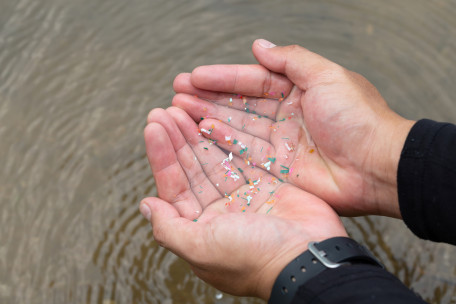Unraveling the Dynamics of Antibiotic-Resistant Genes and Pathogens in Microplastic Biofilm in Marine Aquaculture Environment: Assemblage, Dissemination, and Associated Environmental and Health Implications
- Project Scheme:
- General Research Fund
- Project Year:
- 2024/25
- Project Leader:
- Dr Cheng, Jinping
- (Department of Science and Environmental Studies)

This project aims to investigate the recruitment, development, and spreading of pathogens and antibiotic-resistant genes from marine aquaculture farms to microplastic biofilms and subsequently to fish and coastal waters.
Around 171 trillion plastic particles weighing more than two million tonnes are currently afloat in the world’s oceans, and the resulting economic loss is estimated at US$1.3 billion. At the same time, annual production of aquaculture has reached an annual output of 85 million tonnes, playing a crucial role in ensuring food security. In certain coastal environments, microplastics derived from fisheries and aquaculture activities can account for over 60% of the total microplastic pollution, posing a potential threat to the biological safety of seafood and public health. Microplastics can provide a unique microhabitat for the colonization of opportunistic pathogens and microbes with antibiotic resistance in the aquaculture environment, thereby enhancing their transmission to farmed species and humans through various pathways. The pressing global environmental and health crisis of antibiotic-resistant bacterial pathogens is predicted to surpass cancer in terms of fatality rates by 2050. The pervasive occurrence of antibiotic pollution within aquaculture farms may stimulate the proliferation of antibiotic-resistant bacteria and facilitate the transfer of antibiotic-resistant genes by microplastic biofilm. However, the precise mechanisms and impacts associated with the selection, enrichment, and dissemination of antibiotic-resistant genes and pathogens through microplastic biofilm in marine aquaculture environment remain poorly understood. Particularly, the mechanisms governing the dynamic assembly of microbes, pathogens, antibiotic-resistant genes, and their subsequent transmission to fish and the environment, despite their evident significance, remained poorly understood. This project aims to investigate the recruitment, development, and spreading of pathogens and antibiotic-resistant genes from marine aquaculture farms to microplastic biofilms and subsequently to fish and coastal waters. Attempts will be made to delineate the key drivers shaping the diversity and mobility of pathogens and resistome in this important ‘coastal ecosystem-plastic biofilm-fish-water’ pathway. The proposed research will not only provide a comprehensive understanding of the environmental and public health risks posed by pathogens and antibiotic-resistant genes associated with microplastic pollution, but also shed light on protective measures for coastal ecosystems, seafood safety, and public health.








